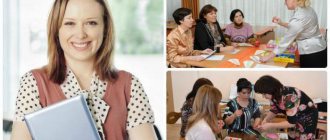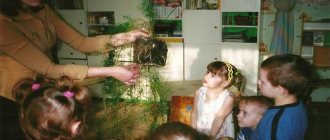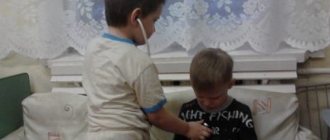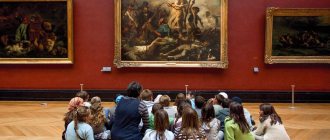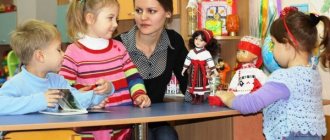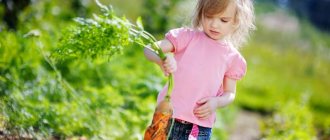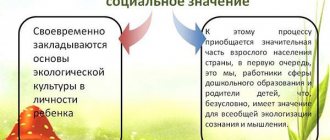Five stages of a plan for self-education on the topic of ecology
Stage I – informational and analytical. Selection of self-education topics for educators
At this stage, psychological and methodological literature is studied and environmental topics for self-education for educators are selected. A long-term work plan is drawn up, exhibitions of games and manuals are organized, experiences in environmental education of preschool children are summarized, and an exhibition of crafts made from vegetables, fruits and leaves is organized together with parents.
Stage II – implementation into practical activities
At this stage, software and methodological support for the educational process is developed. The form of dissemination of experience is:
- calendar and thematic planning;
- visual material;
- viewing teaching activities;
- preparation of leaflets, questionnaires, recommendations and advice for parents, teachers and children;
- selection of methodological equipment and replenishment of the methodological piggy bank;
- drawing up a long-term work plan.
Stage III. The self-education plan for ecology at a preschool educational institution is a representation of work experience on an environmental topic.
Notes are drawn up for classes, consultations for parents, teachers, and entertainment for environmental education. Next, self-analysis of educational work is carried out, the results of the work are diagnosed and monitored, reports are drawn up in the form of information sheets in tables with the results.
Stage IV – working with the family
Parent corners are being set up on the topic “Memorizing poems about the seasons.” Folders are made on the following topics: “Forest treasures”, “Bird life in winter”, “Do not harm nature”, “What plants talk about”. They produce family newspapers, photo exhibitions “The best vacation spots in our village,” and also read “The Amazing Book World” as a way to improve parents’ environmental awareness.
Stage V – activities for children
At this stage, events for children “Autumn Gifts”, “The Natural World Through the Eyes of Children” are being held, wall newspapers “The World of Ecology in the Life of Little Ones”, “Take Care of Natural Resources”, “Little Ecologist”, “Green First Aid Kit” are being prepared. Riddles are asked, poems on ecology are recited, observations are made, themed walks are carried out, and posters are made in defense of the natural world.
For preschool children, ecology in Dow and self-education of teachers is aimed at creating and implementing such entertaining ideas as:
- enriching and systematizing preschool children’s knowledge about ecology, the natural world, objects and phenomena of the outside world;
- development of memory, attention, imagination, thinking, speech, sensory skills in preschool children;
- developing a desire to act with various toys and games, encouraging creativity in play, independence and initiative;
- nurturing creative independence, developing friendliness and discipline;
- fostering a culture of fair competition in competitions.
Self-education of a teacher at Dow in ecology increases along with reflection on what our kids lack. Many teachers, engaged in self-education, have come to the conclusion that preschool children are indifferent to the world around them, do not notice this or that natural object, and they do not have a sense of oneness with nature.
According to many teachers, to understand ecology and the natural world, a child must be given not only knowledge about it, but also taught to listen and empathize with natural phenomena, taught to see how the grass turns green, how the birds sing, what sound the wind makes. Then the inner world of children will also be enriched. But it is impossible to do without training the teacher himself and enriching his work experience, so the following webinars will be useful for the teacher:
- “How to organize a nature area in a preschool educational institution: methodological tools for educators”;
- “Virtual excursions to preschool educational institutions as a means of environmental education for preschool children.”
Work plan for self-education “Environmental education of preschool children”
Polina Smelyanets
Work plan for self-education “Environmental education of preschool children”
Relevance:
The natural world is rich and diverse. But intensive human activity constantly makes changes to it, disturbing the ecological balance of the environment. That is why it is so important to study it and take care of its protection. In order for everyone to realize the significance of this national cause, it is necessary to instill in a person a love of nature from childhood.
Preschoolers look at the world around them with great interest, but they don’t see everything, sometimes they don’t even notice the main thing. It is very important to be surprised with them, to encourage them not only to look, but also to see, the desire to learn even more.
Fascinating observations on walks, first independent experiments, and developmental activities will help young children understand and comprehend the elementary connections of living and inanimate nature in an accessible form. They create conditions for the formation of moral and aesthetic qualities of the future citizen, a defender not only of himself, his fatherland, but also of all the most beautiful things that nature has created.
Goal: Increase your theoretical and practical level of professional skills and competence; systematize the work on implementing a system of activities aimed at forming the foundations of children’s ecological culture, their understanding of elementary relationships in nature, and developing initial practical skills in interacting with natural objects.
Tasks:
• Form basic environmental knowledge and ideas
• Systematize and deepen knowledge about living and inanimate nature.
• Teach to understand cause-and-effect relationships, show the relationship of plants and animals with each other and with the environment; show the diversity of living organisms and their communities; to form the idea that man is a part of nature, his life depends on the state of natural objects, on the environment, and their preservation is the responsibility of man.
• Form a friendly attitude towards living beings in the process of communicating with them.
• Develop a responsible and caring attitude towards animals; teach children to interact correctly with nature.
• Develop labor skills and abilities to care for indoor plants, and rationally use natural resources.
• Improve and enrich the subject-development environment of the group for the development of fine motor skills.
• Increase your own level of knowledge by studying scientific and educational literature; studying methods and technologies of teachers on the Internet.
Forms of work:
• Joint activities of the teacher with the children;
• Individual work with children;
• Free independent activity of the children themselves;
• Consultative work with parents.
Predicting the result:
1. Reassessment of pedagogical values, one’s professional purpose; desire to improve the educational process.
2. Increasing your theoretical and practical knowledge, skills, professionalism and creativity.
3. Development of children's creative abilities and communication skills.
4. Involving parents in participating in group activities (drawing competitions, crafts, replenishment of the development environment, etc.).
5. Creation of an educational environment that forms a developed, socially adapted, enthusiastic personality, consciously using knowledge about nature;
6. Formation in children and parents of a conscious, caring attitude towards nature.
Long-term work plan:
Stage I – Preparatory:
Studying methodological literature on the topic, analyzing experience in Internet resources;
Collecting information to create a file of conversations about nature, observations and experiments
Stage II – Practical:
Development of a long-term project “Seasons”:
• Production of manuals for conducting educational activities, didactic games, role-playing games.
• Creating a file of observations and conversations during a walk.
• Making a card index of didactic games, finger games, on the topic “Seasons”, “Vegetables”, “Fruits”, “Domestic and wild animals”, “Wildlife”, “Inanimate nature”, “Environmental protection”, “Adult labor” ", "Insects". “Plants”, “Flowers”, etc.
• Reading fiction on the topic of self-education (poems, fairy tales, stories, proverbs, riddles)
• Listening to music and performing rhythmic movements on the topic of the project
Work with children:
• Conducting educational events, organizing role-playing, didactic games to get to know and consolidate children’s knowledge on the topic of self-education.
• Creation of a set of demonstration and handout material for GCD
• Organization and holding of themed leisure activities and holidays (“Autumn Festival”, “New Year’s Matinee”, “Maslenitsa”, “Matinee dedicated to March 8”)
• Conversations with children on safety precautions
• Learning poems with children, guessing riddles
Working with parents:
• Consultations for parents
• Design of traveling folders “Autumn”, “Teaching a child to observe changes in nature”, “Winter”, “Spring”, “How to help birds in winter?”, “How interesting it is to spend a walk with a child in winter?”,
• Organization and holding of exhibitions of joint artistic creativity of parents and children (Autumn exhibition “Gifts of Nature”, “New Year’s Toy”, “Winter”, “Maslenitsa”)
• Organization of photo exhibitions “Golden Autumn”, “Winter-winter”, “Spring is knocking on the windows”
• Participation in the “Let's Help the Birds” campaign (creation of feeders)
• Participation in the “Good Caps” campaign
Stage III – Summarizing: Summing up. Drawing up a report on the work done on the topic of self-education and presentation.
Long-term planning for the 2021 – 2021 academic year:
October
— A targeted walk around the territory of the kindergarten. Observing seasonal changes in nature in the kindergarten area. To form in children ideas about the state of plants in autumn, to develop memory and attention
— Conversations “What grows in the garden”, “What are the benefits of vegetables”. Reinforce the general concept of “vegetables”, the names of various vegetables, tell children about the benefits of vegetables and fruits for humans (a source of vitamins, a tasty food product). Strengthen the ability to hold a pencil correctly and paint without gaps in a certain direction.
- P/n “Cucumber, cucumber”, “Move vegetables from hoop to hoop”, “Edible - inedible”, “Where we were, what we did”, “Repeat the movements.” Develop agility, speed, and develop the ability to act on a signal
— Viewing presentations “Monster Vegetables”, “Gifts of Autumn”. Introduce children to the fruits of vegetable crops. To consolidate knowledge about the place where they grow - the vegetable garden. Strengthen the ability to describe a vegetable according to its characteristic features, according to the diagram. Foster a sense of gratitude towards nature and people who, thanks to their work, receive a harvest
— Reading fiction: Y. Tuvim “Vegetables”, Russian. adv. fairy tale “Tops and Roots”, Russian. adv. Fairy tale “Turnip”, M. Druzhinina “Merry Garden”, V. Stepanov “The Hare Had a Garden”, N. Nosov “Cucumbers”, K. Ushinsky “The Story of an Apple Tree”. To develop the ability to listen carefully to a fairy tale, to involve in all possible participation in the dramatization of a fairy tale
— Didactic games “What grows where”, “Harvesting”, “Vegetables and fruits”, “What is missing”, “Know by smell”, “Know by taste”, “Wonderful bag”. Consolidate acquired knowledge, develop attention, speech, memory, imagination.
— Finger games “We are chopping cabbage”, “Hare and a head of cabbage”. Develop fine motor skills of the fingers and a sense of rhythm.
November
- Examination of illustrations, paintings depicting fruits, dummies. Consolidate acquired knowledge, develop attention, speech, memory, imagination
— Viewing presentations “Favorite beauties of autumn.” To develop the ability to create a game plot, teach simple game actions and game interaction, and consolidate knowledge on the topic.
— Conversations: “In the autumn forest”, “Autumn. What do you know about her?”, “How to dress correctly in the fall for a walk?” To develop children's creative activity, consolidate knowledge of the content of works, develop expressive speech, cultivate perseverance, and the ability to enter into dialogue.
— Drawing “Autumn.” Strengthen children's knowledge about autumn. Continue to evoke an emotional response in them when listening to poems about autumn. To consolidate knowledge of the names of some trees: rowan, birch, aspen, spruce. Strengthen the ability to paint with a brush, gouache using the dipping method; develop rhythm in drawing.
— Application “Leaves are falling, falling, leaves are falling in our garden.” Develop the ability to admire the beauty of autumn, pay attention to the changes that have occurred with flowers, shrubs, and trees. Cultivate a sense of beauty; strengthen the skills of spreading glue and gluing leaves
— Didactic games “Seasons”, “Collect a picture”, “Let’s tell the bear about the beauty of autumn nature”, “Find a tree according to the description”, “Which branch is the child from”, “What grows where”. Consolidate acquired knowledge, develop attention, speech, memory, imagination
— Finger Theater “Turnip”. Develop the ability to create a game plot, teach simple game actions and game interaction, consolidate knowledge on the topic
December
— Conversation: “Hello, Zimushka-winter!” Expand children's understanding of the characteristic features of winter nature, develop conversational speech and memory; cultivate curiosity
— Didactic game: “Colored mittens.” Teach children to select objects by color and size. Develop tactile sensations and fine motor skills of the hands. Cultivate interest in the game
— Conversation: “Don’t eat snow, you might get sick!” Form basic rules of conduct while walking; develop a desire to take care of your health
— Application “Snowflakes are falling.” Introduce children to a new type of applique - tearing (tear small pieces from a sheet of paper, apply glue to them and stick them on cardboard)
— Reading the poem by S. Marshak “The snow is pouring, pouring.” Introduce children to the poem by S. Marshak
— Conversation: “Soon, soon, New Year!” Encourage children to talk about how their family is preparing for the new year. To cultivate a caring attitude towards the surrounding world, towards nature, the ability to notice the beauty of winter nature
— Collective application: “Let’s decorate the Christmas tree.” Teach children to carefully glue the details of the image; develop creative imagination; cultivate a desire to perform teamwork
— Making New Year cards for parents. To create a desire in children to please their loved ones with handmade gifts
— Outdoor games: “The little white bunny is sitting,” “Let’s make a snowfall.” To develop the desire in children to play outdoor games that help improve basic movements (walking, running, throwing, to cultivate a desire to play together and have fun
January
Drawing "Winter Forest". Review basic drawing techniques. Strengthen the ability to draw with paints; cultivate a desire to admire the beauty of the winter forest
— Modeling “Icicles”. Continue teaching children to pinch off lumps from a large piece of plasticine. Roll lumps of clay between your palms. Cultivate an interest in sculpting
— Didactic game: “Assemble a Snowman.” Continue to introduce children to geometric shapes. Develop the ability to assemble a snowman from three parts of different sizes. Cultivate interest in the game
— Word game: “What do we like in winter?” Teach children to name winter fun and entertainment; develop interest in winter fun
— Dramatization of the fairy tale: “Zayushkina’s hut.” Teach children to listen to a fairy tale in a dramatized version; develop a love for animals
— Outdoor game: “Roll a snowball.” Improve basic types of movements. To develop children's desire to play outdoor games, to cultivate a desire to play together and have fun
February
— Examination of plot pictures about winter. Encourage children to look at pictures about winter. To cultivate a caring attitude towards the surrounding world, towards nature, the ability to notice the beauty of winter nature
— Review of the album: “Wintering Birds.” Introduce children to the image of birds in winter; develop a desire to recognize the bird, name its body parts; develop a caring attitude towards birds
— Conversation based on the painting: “It’s good in winter.” Interest in winter fun. To arouse the desire of children, on their own initiative or at the request of the teacher, to talk about what is depicted in the picture, to develop children’s speech; cultivate curiosity
— Collective work on artistic creativity (sculpting): “Snowman” Continue to introduce sculpting techniques. Strengthen the ability to roll out plasticine in a circular motion. Foster a desire to sculpt from plasticine
— Drawing “Snowman”. Exercise children in drawing objects of round shapes, exercise their ability to compare objects by size. Strengthen the skills of painting a round shape, repeating the outlines of the drawn figure
— Reading poems about winter. Continue to introduce children to poems about winter; develop a desire to listen to poetry carefully; cultivate a love for winter
— Conversation: “Slippery road.” Introduce children to the rules of behavior on the road. Develop conversational speech and memory. Cultivate attention
— Conversation: “When it’s freezing outside, you can freeze your nose.” Continue to introduce children to safety rules in winter and when handling objects. Form the foundations of a healthy lifestyle
— Dramatization game: “Mitten.” Arouse children's interest in theatrical play. Develop the ability to monitor the development of actions in dramatization games and puppet shows. Foster a love of fairy tales
— Experiments with snow: “It melts - it doesn’t melt.” Continue experiments with snow; introduce the properties of snow; cultivate curiosity.
— Printed board games: Match by color, Find the extra one. Teach children to select objects by color and size. Develop tactile sensations and fine motor skills of the hands. Cultivate interest in the game
— Conversation: “How do animals prepare for winter?” Clarify and expand children's knowledge about animals in winter; develop conversational speech; cultivate a desire to help animals in winter
— Reading a Russian folk tale: “The Snow Maiden.” Introduce children to the Russian folk tale: “The Snow Maiden.” Develop a desire to listen to a fairy tale. Cultivate respect for adults
— Conversation: “Goodbye, Zimushka-winter!” Systematize and summarize knowledge about winter; tell children that winter brings us a lot of joy (outdoor games, holidays, the beauty of winter nature, seasons change each other. Foster positive emotions
March
— Examination of illustrations, albums “Spring”, “Birds”, “Animals”. Consolidate acquired knowledge, develop attention, speech, memory, imagination
— Weather observations. Teach children to pay attention to how nature has changed
— Drawing “Mimosa sprig.” Learn to draw a mimosa by dipping it with your finger. Practice the skill of applying paint close to the branch. Develop creativity and artistic taste
— Application “Birdhouses”. Teach children to depict in appliqué objects consisting of several parts, determine the shape of the parts
— Plasticineography “It’s time to plant trees.” Develop eyes, fingers, excite imagination and imagination.
— Reading fiction: Memorizing poems about spring. Making riddles. Using proverbs, sayings about spring, explaining their meaning. To cultivate a caring attitude towards the surrounding world, towards nature, the ability to notice the beauty of spring nature
— Conversation “Dangerous Ice.” Repeat the rules of safe behavior in nature and on the street
— Entertainment “Spring is coming to us.” To create a desire in children to please their loved ones
— Caring for indoor plants. Reinforce knowledge about the basic needs of indoor plants
— P/i “Sun and Rain”, “Through the Stream”, “Birds and Chicks”, “Birdhouses”, “Catch a Mosquito”. Improve basic types of movements. To develop children's desire to play outdoor games, to cultivate a desire to play together and have fun
April
— Viewing presentations “Walk in the spring forest.” Tell children about the awakening of life in the forest after winter.
- Looking at the pictures “Ice drift”, “Spring has come”. Challenge children to talk
— Collective application “We welcome spring.” Develop a sense of collectivism, create an emotional mood for children
— Observation of seasonal changes on the site (melting snow, puddles, streams, icicles, birds, buds, first leaves, first grass, dandelions, janitor work). Form ideas about changes in nature, teach to distinguish and characterize the signs of spring, cultivate a love of nature
- Reading fiction: L. Tolstoy “Spring has come...”, E. Karganova “Spring”, K. Ldov “Swallow”, L. Agracheva “Haunted Cheerfully”, M. Borisov “Drop Song”. Develop children's creative imagination
- D/i “Fold the picture”, “What did the artist mix up?”, “Whose baby?”, “Seasons”, “Who lives where?”, “What is good and what is bad”, “Dress the doll.” Development of memory, thinking, attention
— Finger games “Sprout”, “Boat”, “Spring”, “Insects”, “Snowdrop”. Improve basic types of movements. To develop children's desire to play outdoor games, to cultivate a desire to play together and have fun
— P/n “On a level path.” To develop in children the ability to move rhythmically, to coordinate movements with words
May
— Drawing “Ladybug”, “Dandelions in the grass”. Develop artistic abilities
— Reading fiction: “Spring, red spring.” Skrebitsky G. “Spring in the Forest.” Formation of interest and need for reading books.
— Educational stories “What are birdhouses for”, “Primroses”. Develop children's cognitive interest.
— Viewing presentations “Journey to the clearing.” To form in children pride in the beauty of their native nature; cultivate culture.
- Games and fun “Sunny bunnies”, “Boats are sailing and sailing”. Develop agility, speed, and develop the ability to act on a signal.
